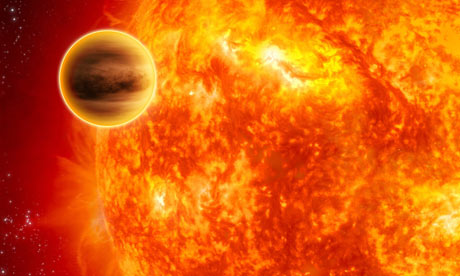 get what you want and get out
get what you want and get out

Jupiter Facts You Might Not Know About
If you weigh 100 pounds on Earth, you would weigh 264 pounds on Jupiter.
Jupiter has a mass 318 times greater than the Earth's and a diameter that is 11 times larger.The mass of Jupiter is 70% of the total mass of all the other planets in our Solar System. Jupiter's volume is large enough to contain 1,300 planets the size of Earth.
Jupiter rotates faster than any planet in the Solar System.It rotates so quickly that the days are only 10 hours long... But it takes 12 Earth years for Jupiter to complete an orbit around the sun. The great red spot on Jupiter is a storm that has been going on for over 300 years.
You can fit 100 Earths into Jupiter's great red spot. Jupiter has the biggest moon in the Solar System, Ganymede. It is even bigger than Mercury and Pluto.Jupiter has a ring just like Saturn and Uranus. The Planet has over 60 known satellites (moons) but most of them are extremely small and faint. Jupiter is covered by an ocean of hydrogen with a sludge-like consistency.
Unlike other planets, Jupiter sends out a strong radio radiation that can be detected on Earth. In 1994, pieces of a comet called shoemaker-Levy 9 broke apart and crashed into Jupiter. This left patches in Jupiter's atmosphere that lasted for many months.Planet Facts Jupiter is the fourth brightest object in the sky (after the Sun, the Moon and Venus). It has been known since prehistoric times as a bright "wandering star". But in 1610 when Galileo first pointed a telescope at the sky he discovered Jupiter's four large moons Io, Europa, Ganymede and Callisto (now known as the Galilean moons) and recorded their motions back and forth around Jupiter. This was the first discovery of a center of motion not apparently centered on the Earth. It was a major point in favor of Copernicus's heliocentric theory of the motions of the planets (along with other new evidence from his telescope: the phases of Venus and the mountains on the Moon). Galileo's outspoken support of the Copernican theory got him in trouble with the Inquisition. Today anyone can repeat Galileo's observations (without fear of retribution :-) using binoculars or an inexpensive telescope. Jupiter was first visited by Pioneer 10 in 1973 and later by Pioneer 11, Voyager 1, Voyager 2 and Ulysses. The spacecraft Galileo orbited Jupiter for eight years. It is still regularly observed by the Hubble Space Telescope. The gas planets do not have solid surfaces, their gaseous material simply gets denser with depth (the radii and diameters quoted for the planets are for levels corresponding to a pressure of 1 atmosphere). What we see when looking at these planets is the tops of clouds high in their atmospheres (slightly above the 1 atmosphere level).
Jupiter is about 90% hydrogen and 10% helium (by numbers of atoms, 75/25% by mass) with traces of methane, water, ammonia and "rock". This is very close to the composition of the primordial Solar Nebula from which the entire solar system was formed. Saturn has a similar composition, but Uranus and Neptune have much less hydrogen and helium. Read more about Jupiter l Jupiter facts, pictures and information. by nineplanets.orgName Jupiter Meaning of Name Roman King of the gods and ruler of Olympus. Greek equivalent is Zeus, son of Cronos (Saturn) Name in Foreign Languages Jupiter (French, German, Latin), Júpiter (Spanish, Portuguese), Giove (Italian), Yupiter (Russian), Zeus (Greek) Average Distance from the Sun 778,412,020 km / 483,682,810 miles / 5.203 A.U. Comparison with Earth: 149,597,890 km / 92,955,820 miles / 1.000 A.U. Closest
Distance to the Sun (Perihelion) 740,742,600 km / 460,276,100 miles / 4.952 A.U. Comparison with Earth: 147,100,000 km / 91,400,000 miles / 0.983 A.U. Farthest Distance from the Sun (Aphelion) 816,081,400 km / 507,089,500 miles / 5.455 A.U. Comparison with Earth: 152,100,000 km / 94,500,000 miles / 1.017 A.U. Diameter across equator 142,984 km / 88,846 miles Comparison with Earth: 12,756 km / 7,926 miles
Jupiter is the largest planet in our Solar System. Ancient Astronomers named Jupiter after the king of the Roman Gods. Jupiter is the 5th closest planet to our sun. The atmosphere of Jupiter consists of about 84 percent Hydrogen and about 15 percent helium, with small amounts of acetylene, ammonia, ethane, methane, phosphine, and
http://www.planetfacts.net/Jupiter-Facts.html this is where i got my rescources
This is the body!!! CANT BE SCARED!!
 get what you want and get out
get what you want and get out
